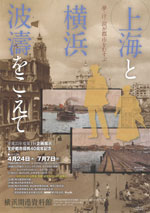- Top page
- Language
- Para Residentes (persona que vive en Yokohama)
- English
- Sobre la Ciudad de Yokohama (sobre Yokohama-shi)
- Otro (otros)
- Información (información de administración municipal) de Administración de ciudad
- Internacional (internacionalmente)
- La Hermana de Yokohama / Friendship Cities
- Yves on the Shore
- 40 Years of Friendship
Main content starts here.
40 Years of Friendship
Última fecha puesta al día: 2018/9/28
40 Years of Friendship

Conmemorando el 40 anual de ciudad de amistad ata entre Shanghai y Yokohama, los Archivos del Yokohama de Historia están sosteniendo actualmente a la vez una exhibición especial en las ciudades cuando los puertos asiáticos estaban abriendo al resto de la "Shanghai titulado mundial y Yokohama, Más allá de los Mares Rodantes." The Port of Shanghai was opened in 1843. Sixteen years later, in 1859, the Port of Yokohama followed suit. Las dos ciudades desarrollaron rápidamente como cubos para el comercio con otros países – "Nippon Yusen Kaisha" y "Peninsular y oriental que la Compañía de la Navegación De vapor" incluso había afianzado a tiempo a los corredores marítimos ya en ese momento – y claro el comercio entre sí. And that is the relation the exhibition mainly explores.
Leading to the exhibition hall are comparative pictures of Shanghai and Yokohama as they were at the time and as they are now. Besides the many historical pictures and documents, the exhibition offers some bigger pieces such as a wooden piano near the entrance or a red Chinese dress facing it. Si no lees japonés, hago pensar en la ida con un amigo japonés para entender más bien lo que estás viendo.
For example, the S. Mastica el piano – uno de sólo 12 que permanece en el mundo – era hecho en el Chinatown de Yokohama por 1 inmigrante de la generación Sr. Shosei Chew (Zhou en chino, pronunciado 'el shoo'). Born in the Zhenhai district in the Province of Zhejiang, China, he polished his skills in Shanghai under a British piano company before moving to Japan in 1905, where he became shop supervisor for a different firm. In 1912, he opened his own company in Yokohama Chinatown. His son succeeded to the business after his father died in the Great Kanto Earthquake of 1923. Their piano factory in what is now Minami Ward kept running until it was lost to air raids in 1945. En recientes años, doce "S. Chew" los pianos (hecho por Mastica a la persona mayor) y seis "S. Chew & Hijos" que los pianos (hecho por Mastica al junior) han pulido aquí y allí para un total de 18 pianos.
The Chinese dress is interesting for it is made from polyester. Si eres algo como mí, cuando piensas en vestidos chinos, piensas seda. But in the 1920s, polyester was a much newer and rarer, hence more sought after, material. (Una nota lateral para los aprendices japoneses: Busca el equilibrio de los importadores reserva en la exhibición. It was my first time to see the kanji compound for polyester!)
At the time, the Chinese population in Yokohama was famous mainly for 2 items: western clothes (because there was previously no way to make them in Japan) and pianos. Thanks in part to this, Yokohama rapidly attracted a large population of craftsmen rather than workers as is the case in countries like Canada and the U.S. where Chinese immigrants often had to take on labors such as building railways. And probably because most shops were aimed at foreigners, most signage in the pictures on display was in English. I was very surprised to see this, since now almost none can be seen.
Among the hundreds of old tools, pieces of clothing, documents, pictures and maps, the exhibition counts old labels from a silk trading company from Yokohama. The marketing put into them is quite remarkable, with images tailored to each country where they did business. Hay también muchos tesoros de literatura como un libro en Shanghai no escrito por ninguno de otra manera que Eliza Scidmore (de la fama de lozanías de cereza) así como Hepburn muy primero el diccionario japonés-inglés imprimió en Yokohama. There is also a part dedicated to Ginko Kishida, a journalist and businessman of the Meiji era. On top of editing the Hepburn dictionary, he is famous for publishing the very first newspaper in Japan as well as manufacturing eye drops. He was mainly active in Yokohama and Shanghai.
As for a living heritage of the history between the 2 cities, look no further than Tomsung & Co. on Honcho-dori, just a few steps from the venue of the exhibition. Originating from Ningbo city in the Province of Zhejiang, this Chinese tailor has been operating in Yokohama since the end of the Meiji era. Se dice que su ciudad natal es el lugar de nacimiento de "sastres de Shanghai." Not only has the place been there forever, it has been passed down strictly within the family and so the traditional techniques and skills learned over generations are still alive today. I have had the pleasure of meeting the man when I went in for adjustments on a suit. En el momento, no supe que su negocio tenía tal una historia larga. One this is for sure, his skills are outstanding.
Puedes coger la exhibición a los Archivos del Yokohama de Historia (el sitio externo).
Shanghai and Yokohama, Beyond the Rolling Seas
Note: This exhibition is over.
Dates: 24 de abril – 7 de julio de 2013
Time: 9:30 a.m. .5 p.m.
Entrance fee: Adulto – 200 yen; Medio estudiante escolar y más joven – 100 yen
Address: 3, Nihon Odori NakaWard, Yokohama 231-0021
(Cette compaginan el français del en)
Note: This exhibition concluded in July 2013. Sin embargo, todavía hago pensar en visitando las exhibiciones especiales permanentes y actuales a los Archivos del Yokohama de Historia (el sitio externo).
Botones ID: 432-923-415

